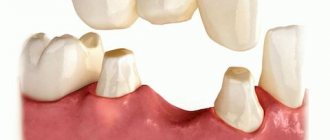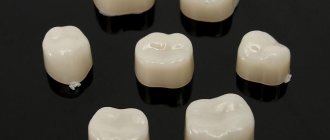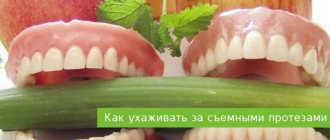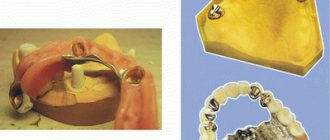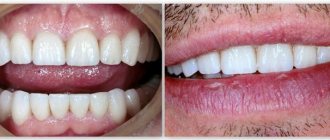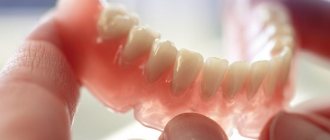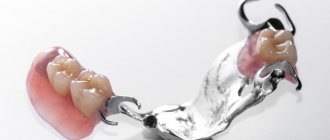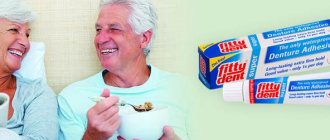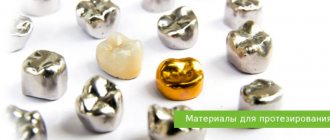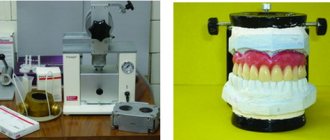Children's dental prosthetics is an opportunity to quickly restore a damaged, lost or missing primary or permanent bite unit. The dental procedure takes 20-40 minutes and is suitable for children of almost any age.
Any tooth loss before the child reaches 6 years of age is considered abnormal and requires urgent solution to the problem.
The lack of timely prosthetics leads to problems with chewing and speech, and provokes the development of bite pathologies.
Why do you need dentures for baby teeth?
Prosthetics of primary teeth involves the restoration of damaged or extracted teeth in children using artificial materials. In this case, you can install either one denture or a bridge of several crowns. It used to be that only adults needed dentures. But relatively recently, doctors came to the conclusion that premature loss of baby teeth seriously impairs chewing function and negatively affects the child’s overall health. In addition, the absence of baby teeth significantly spoils the baby’s appearance and, as a result, undermines his self-confidence. Therefore, today parents, concerned about the mental and physical condition of their children, are increasingly turning to clinics for prosthetics of baby teeth, thereby ensuring the continuously growing popularity of this area in dentistry.
Reviews
Dmitry Surovy
08/22/2021 at 15:38
Excellent pediatric dentistry! I really enjoyed all three visits! They came twice to remove pigmentation, once for a routine examination. The 2.5 year old child behaved calmly and fearlessly. After visiting they give you a gift))) I recommend it to everyone!
Alla I.
08/04/2021 at 14:37
We have been seeing the clinic for a long time, about 6 years, with the same dentist-therapist. I like the quality and service. Sometimes we visit a hygienist until we find a doctor who would suit us 100%. At first, the two-year-old child was very afraid to have his teeth treated, but the doctors at the clinic managed to find an approach. And they saved all our teeth.
Natalya F.
03.08.2021 at 17:01
We treat our teeth with Dr. Nenko. A very excellent doctor. My child was scared at 2 years old in a regular clinic so that he cried when he heard the word from the dentist. And he went to Alexander Vladimirovich with a smile. And now he is already 13 years old, but he only goes to him. I am very grateful to this doctor. Thank you very much !!! And regarding the prices. Damn, the prices are stinging right now. I'm not a millionaire. But wherever I was, the child was not treated better than in cramming. And really...
Katya M.
08/03/2021 at 10:11
We treat our teeth with Dr. Nenko. A very excellent doctor. My child was scared at 2 years old in a regular clinic so that he cried when he heard the word from the dentist. And he went to Alexander Vladimirovich with a smile. And now he is already 13 years old, but he only goes to him. I am very grateful to this doctor. Thank you very much !!! And regarding the prices. Damn, the prices are stinging right now. I'm not a millionaire. But wherever I was, the child was not treated better than in cramming. And really...
Sergey
07/18/2021 at 21:15
Expensive - but the kids love it! It's not scary to have your teeth treated there!
Natalya Mostovaya
07/14/2021 at 19:55
The main thing is to find your doctor, who is, first of all, a professional, will establish contact with the child, teach him how to take care of his teeth, and therefore his health. We were lucky! Since our daughter was three years old and for 7 years now, we have been entrusting her teeth to the dentist Nenko Alexander Vladimirovich. Thank you, our beloved doctor!
Irina K.
07/02/2021 at 10:22
Excellent pediatric dentistry, the child enjoys going there. They don’t impose anything, they suggest that you decide for yourself. I can’t say about the prices; I have nothing to compare with; we came here once and are not going anywhere else. The prices are quite reasonable for me.
Call me O
06/15/2021 at 11:43
The best place! Just the tooth fairy's house! A 2-year-8 month old baby sits in a chair for cleaning without any problems, we hope that we can also heal a small hole in a tooth without any problems.
Evgeniy Eremin
06/05/2021 at 21:03
Nice place, attentive doctors. I've been driving my daughter for two years now (4 years). Not afraid! Everything is fine!
Andrey Skibin
05/29/2021 at 19:20
We have been going with our child for 9 years now. No complaints.
Marina Marina
05/27/2021 at 09:47
Children enjoy going to the dentist. Polite staff. In general, although not cheap, it is worth the money.
Stanislav Mironov
05/19/2021 at 12:47
Good dentistry for children.
Elina Monakova
05/16/2021 at 10:48
Now we only go to Tarasova, an excellent doctor, a competent specialist, she communicates very kindly and gently with children, and so does her assistant. I can’t say the same about the others; they saw other doctors, but they didn’t like them, and they didn’t treat their teeth. Very expensive. But we go because of the doctor, his experience and attitude.
Andrey Nazarov
05/15/2021 at 15:43
Good doctors. Reasonable prices. Saved more than one child's teeth. I recommend.
Aleksandr Vladimirovich
05/13/2021 at 12:19
Get your child's teeth done, only here!
Hope
04/29/2021 at 11:33
The quality is top notch. Without further ado, just to the point. The price will drop on the spot. But you won't find this quality in others.
Olga Zhurko
04/28/2021 at 14:11
We have been going to this clinic for several years. I like quality service, good equipment. The employees are always pleasant and polite in their communication, from the dressing room to the doctors. The price tag is average. There are always cartoons for children during procedures and gifts afterward. And of course, our wonderful doctor, Tsutskikh A.V., is beyond praise!
I like quality service, good equipment. The employees are always pleasant and polite in their communication, from the dressing room to the doctors. The price tag is average. There are always cartoons for children during procedures and gifts afterward. And of course, our wonderful doctor, Tsutskikh A.V., is beyond praise! The child walks almost with pleasure, if you can say that about visiting the dentist)
The child walks almost with pleasure, if you can say that about visiting the dentist)
Anna Kmet
04/22/2021 at 15:55
We have known the Zubryonok clinic for a long time. We like everything about it: the staff, the approach to the little patient, and the result has always pleased us. The price is reasonable for the current times. Prices are no higher than in public clinics, and the approach is completely different. The last time we were at a reception, I was especially pleased with the work of Maxim Alexandrovich Goncharov! The doctor completely restored our front tooth, making it identical to the lost one. I can't even before...
Elena
04/11/2021 at 18:19
A wonderful clinic, a real nursery, where everything is for the child’s comfort. Special thanks to the doctor, Nenko Alexander Vladimirovich, for his patience, individual approach and professionalism. My son was terrified of having his teeth treated (he was 5 years old), but by the end of the treatment he loved going to the dentist and it makes me happy. We treated complex teeth without general anesthesia, quickly and efficiently. Very pleased, thanks again. Sincerely, mother Elena and son Egor.
Alexandra Shevchenko
03/29/2021 at 20:17
Very good dentistry. The child is not scared, the doctors are all in tune with the child; they will entertain, distract, persuade, play cartoons, give small gifts for courage, just to make the treatment as comfortable as possible.
All reviews
Indications for dental prosthetics in children
Only a pediatric dentist can give an accurate answer to the question of whether your child needs prosthetics for baby teeth. Typically, prosthetics of baby teeth in children is carried out if the following indications exist:
- Destruction of a baby tooth by caries and the impossibility of its restoration.
The absence of molars negatively affects the chewing of food, leads to stomach diseases and unwanted weight loss in children. The loss of frontal teeth can provoke the occurrence of speech defects or psychological complexes. - Tooth decay due to fluorosis.
This chronic disease develops even before teeth erupt, and subsequently causes stains on them and leads to their destruction. Dentures for baby teeth help prevent this process and preserve the aesthetics of a child’s smile. - The need for tooth extraction due to inflammation of the periosteum.
This disease often causes the appearance of neoplasms accompanied by pain. Often in such cases, the tooth must be removed. - Loosening or loss of teeth due to periodontitis.
This is a disease that affects the connective tissue between the bone of the tooth socket and the root cement. It can also lead to unwanted tooth loss in a child, and therefore is another indication for dentures for baby teeth. - Early loss of baby teeth.
Loss of a baby tooth a year or more before the appearance of a permanent one leads to shortening of the dentition in the permanent dentition in children, abnormal eruption of permanent teeth and significant disturbances in the dental system. - Tooth injury.
Children, due to their active lifestyle, are much more likely than adults to be injured. And the premature loss of even one baby tooth, as noted above, can lead to undesirable consequences for the child’s body. - Involuntary grinding of teeth (bruxism).
If not treated promptly, this disease can lead to deformation or premature loss of the tooth. - Edentia.
This is a complete or partial absence of teeth, which can be either congenital or caused by objective reasons.
Crowns
Like all children's orthopedic structures, they can be of two types:
- Permanent.
- Temporary.
The latter can be fixative or preventive. They are used when a corner or cutting edge of a tooth is broken off as a result of trauma, to fix the therapeutic material. They are also used to fix devices for various dental defects to prevent tooth displacement.
Important! When performing prosthetics with temporary crowns, tooth preparation is not performed.
Crowns are used in the following cases:
- Bruxism (teeth grinding at night).
- Restoration of permanent teeth after enamel damage.
- Restoration of carious teeth.
- Tooth restoration after pulp removal.
- Complete destruction of the tooth by caries.
- Dental injuries, etc.
Features of dental prosthetics in children
Children's dental prosthetics has its own nuances. Firstly, in adults the jaw is formed, while the child is growing all the time, and the dentist must do everything possible to ensure that the prosthetics of baby teeth does not disrupt the development processes in the body. Therefore, dentures for children must be hypoallergenic, safe, comfortable, and resistant to chemicals. Therefore, for the manufacture of children's dentures, materials such as acrylic, chrome-plated steel, stainless steel, silver and tin alloys are used. Secondly, children's structures should not interfere with jaw development.
According to their purpose, dentures for children are divided into the following groups:
- therapeutic – restore functions and correct the structure of teeth;
- preventive – prevent deformations and pathologies in the development of teeth and jaws;
- fixing – used for fastening orthodontic appliances and therapeutic materials.
Interesting fact!
Hippocrates called children's teeth milk teeth. He was convinced that the first set of human teeth developed from the milk that infants fed.
Benefits of this treatment method
The plates enjoy consistently high popularity and are unlikely to go out of use in the foreseeable future because:
- They are light, comfortable, non-traumatic.
- They are very easy to care for from a hygienic point of view.
- They look quite aesthetically pleasing and do not cause negative emotions even in the most suspicious patients.
- Their installation and correction requires a minimum of time and effort.
- They cause virtually no pain or inconvenience to patients.
- Their cost is always kept at a reasonable level and is accessible to the widest segments of the population.
Types of dentures for children
Typically, children are fitted with fixed, removable or conditionally removable dentures. Removable (temporary) dentures are made according to individual jaw impressions, sometimes with additional elements (screws, springs, arches). In children's dental prosthetics, they are installed when several teeth are missing to widen the jaw or correct the position of the teeth, and they must be regularly replaced as the child grows. Fixed dentures are installed for long-term wear and are removed along with the falling out milk teeth.
Why choose prosthetics at Aza&Buka dentistry
Dental prosthetics for children is a responsible dental procedure. The doctor must take into account many points - characteristics of the bite, growth rates, the presence or absence of certain diagnoses. The prosthetic structure should grow with the child, be comfortable to wear and not interfere with the harmonious development of the patient.
At Aza&Buka, special attention is paid to the safety and quality of dental procedures. Prosthetics in pediatric dentistry is:
- Fast and comfortable. The doctor will conduct a diagnosis immediately during the appointment and select the optimal prosthetic option.
- Complex work of specialists. If necessary, the child will be examined by an orthodontist, a dental therapist, or a dental surgeon. The best decision for the patient will be made.
- Painless at every stage. For especially young children or complex patients, prosthetics will be performed under general anesthesia or deep sedation.
- High quality result. A crown will completely replace a damaged or missing tooth - aesthetically, anatomically, functionally.
- Modern equipment, best brands. Young patients will be offered ready-made dentures or crowns made from acrylic, nylon, ceramics, metal, and zirconium dioxide.
At Aza&Buka dentistry, we provide prosthetics for permanent and baby teeth for patients of any age.
Dentures for teeth
| Type of prosthesis | Material | Characteristics |
| Crowns | Stainless steel, metal alloys, acrylic (Strip crowns) Metal alloys | They are used for partial dental caries damage, trauma, and bruxism. The procedure for installing such prostheses is much faster and easier than conventional filling. In this case, the pulp is preserved, and the tooth is ground according to the method for “adult” prosthetics. During the installation of the crown, the doctor must carefully ensure that the crown does not extend beyond the edge of the gum. Fixed crowns can be placed on children aged 1 to 12 years, as they do not interfere with the natural process of baby teeth falling out. |
| Pins | Metal alloys | The design of the pin for children's dental prosthetics is similar to the design of the pin for adults. The children's pin differs only in a special element for more reliable fixation. As a rule, pins are installed in the roots of the front teeth in the upper jaw and canines in the lower jaw. According to the generally accepted method, the preparation of the supragingival part of the root for subsequent prosthetic restoration with a pin is carried out with carborundum stones. |
| Tabs | Metal alloys | Microprostheses, which are installed in place of missing tissues and recreate the anatomical shape of the tooth. In prosthetics, baby teeth are used to eliminate defects with the obligatory preservation of the dental pulp. |
| Bridges | Stainless steel, metal alloys | A structure consisting of several crowns that is attached to natural teeth. Restores chewing function and preserves the aesthetics of the smile. |
| Immediate dentures | Acrylic, nylon | The most popular type of partial dentures. Used to replace one lost tooth. Almost invisible. It takes some getting used to. It is characterized by the absence of contraindications and is suitable for all patients without exception. |
| Clasp dentures | Nylon | Comfortable, ensure even distribution of load between all teeth. They exactly follow the contours of the gums and are therefore quite complex to manufacture and require several visits to the dentist. Elastic and flexible, they are fixed to adjacent teeth with soft nylon clasps. It takes some getting used to. They do not rub the gums and are almost invisible due to their transparency. |
| Complete overdentures | Acrylic, nylon | Completely replace all teeth on one or both jaws. They are attached to the palate by suction or using a special cream. They are durable and do not require special care. |
Clinical and technical aspects of manufacturing children's removable dentures
Dr. Sandra Siepmann
Department of Prosthetic Dentistry at the University Clinic of Freiburg
Dr. Alexandra Ioana Holst
Clinic No. 3 of Orthodontics at the University of Erlangen -
Nuremberg named after Friedrich-Alexander (Erlangen)
Dr. Stefan Holst
Clinic No. 2 of Prosthetic Dentistry at the University of Erlangen-Nuremberg. Friedrich-Alexander (Erlangen)
Dr. Guido Heydecke
Professor, Clinic of Prosthetic Dentistry at the University Hospital Hamburg Eppendorf (UKE)
The manufacture of dentures in children requires special measures that take more time than when making dentures for adult patients. A condition for successful treatment in children is appropriate treatment of them, including both special and functional as well as psychological aspects. Aesthetically and functionally correctly performed dental restoration can have a positive impact on the development of a child’s self-esteem and self-confidence. This article uses a case study to demonstrate how appropriate handling of a child helps him become accustomed to the dental office environment and treatment procedures.
Introduction
Dental defects in childhood can be either congenital or acquired.
The causes of acquired dental defects can be:
- caries (Einwag, 2002a; Mandroli, 2003);
- trauma (Einwag, 2002a);
- general and local diseases.
Causes of congenital absence of teeth include oligodontia, anodontia, hypodontia, mineralization disorders (Nyguist 1968), microdontia and hypophosphatasia (van Waes & Stoeckli 2001).
Premature loss of baby teeth (less than a year before permanent teeth erupt) can cause a number of complications. These primarily include:
- loss of sagittal and vertical support (Stadelmann, 1988; Beyaert et al., 1991);
- limitation of functions (phonetics, chewing) (Margolis, 2001; Oka et al., 2003a; Oka et al., 2003b);
- development of dyskinesias;
- growth slowdown;
- influence on the process of eruption of permanent teeth (acceleration or delay);
- sometimes also difficulties in social integration (Einwag, 2002a; Lo Muzio et al., 2005).
Possible options for prosthetics in childhood include the manufacture of devices that preserve space in the dentition. Such devices can be made in the form of either a fixed or removable structure (children's removable denture). The choice of the appropriate treatment method largely depends on the cooperation of the little patient with the doctor. During the treatment process, the dentist is required to be much more sensitive than when performing dental procedures on adult patients. In order to achieve the necessary patient cooperation, it is important to take into account special psychological aspects during treatment (Siepmann et al., 2008). The tell-show-do approach produces the best results when treating children over 3 years of age (Chu, 2000; Eaton et al., 2005). Despite the fact that patients' cooperation is insufficient in many cases, they often accept prostheses well (Chu, 2000; Van den Steen & Bottenberg, 2004).
Description of a clinical case
A 5-year-old patient came to the Department of Orthopedic Dentistry at the University Clinic of Freiburg for the first time, accompanied by his mother (Fig. 1).
Rice. 1. Initial situation: portrait photograph of a 5-year-old patient.
Anamnesis
In the clinical case presented here, the general history is unremarkable. The patient is not taking any medications.
Special anamnesis: the patient does not have any aesthetic discomfort, as well as phonetic and functional limitations.
Objective examination data
Estraoral examination
No asymmetry or sensory disturbances are detected.
Extraoral examination from an orthodontic point of view
Harmonious proportions of the face with a conditional division into three parts, straight profile. The position of the jaw in the sagittal and vertical plane is without any features.
Intraoral examination
Minor irritation of the mucous membrane in the area of the gingival margin, serous saliva, palatine tonsils without changes.
Dental condition
Teeth 54, 55, 64, 65, 74, 75, 84 and 85 are covered with prefabricated steel crowns for primary teeth. The 52, 51, 61, 62nd teeth are missing. The condition of the lower jaw teeth (with the exception of a small enamel defect of unknown etiology in the area of tooth 72) is unremarkable (Fig. 2)
.
Rice. 2. Initial situation in the oral cavity (without prosthesis).
To restore the dentition defect in the area of the 52–62nd teeth, a clasp prosthesis was made, fixed on the 54th, 55th, 64th and 65th teeth using Bonville clasps (Fig. 3).
Due to insufficient fixation, as well as functional problems associated with phonetics, insufficient restoration of chewing functions and aesthetics, the prosthesis did not meet the requirements. For this reason, the patient did not recognize the prosthesis and did not use it.
A functional examination also determines the visceral type of swallowing, which is the physiological norm before the eruption of the upper incisors. Despite the absence of anterior teeth, displacement or protrusion of the 73rd and 83rd teeth is not noted.
Rice. 3. Initial situation in the oral cavity. The installed clasp prosthesis does not meet the requirements.
Diagnosis
Partial absence of primary teeth in primary dentition. Condition after therapeutic and surgical sanitation of the oral cavity. The patient was given a clasp denture for the upper jaw that did not meet the requirements.
Treatment
Since the patient was only 5 years old at the start of treatment, it was difficult to predict to what extent cooperation could be achieved between patient and physician and how well the patient would accept the prosthesis. A consultation and explanatory conversation were held about possible treatment measures. After this, based on considerations of proper development of speech and aesthetics, as well as restoration of functions, a decision was made to plan the manufacture of a removable denture for the upper jaw.
When carrying out treatment, special attention should have been paid to measures aimed at overcoming the patient’s fear and achieving cooperation with the doctor.
On the second visit, the patient was introduced to the tools and materials used in a playful way. Skepticism towards a dental mirror, probe and tweezers is reduced if the patient is allowed to examine them with his own hands. In many cases, young patients will no longer be afraid of “drilling” if the rubber polishing cup or rubber polisher is touched to their finger while rotating at low speed (Chu, 2000; Eaton et al., 2005). In this case, the patient's willingness to cooperate with treatment was so high that it was finally possible to have his teeth professionally cleaned.
Taking an impression
In the case presented here, there were no indications for dental filling.
In order to prepare for taking an impression for further production of the prosthesis, the patient became familiar with the materials and instruments used for this. If the patient has an increased gag reflex, you can give the parents home selected impression trays to “practice” for subsequent impression taking. Under parental supervision, the child should try to keep the impression tray (without impression material) in the mouth for as long as possible (Köperich, 2003).
In the case described, at a subsequent visit, it was possible to immediately begin taking impressions from the upper and lower jaws. Before placing the impression tray with alginate mass in the oral cavity, a small portion of the mixed alginate mass was given to the patient. In this case, the child had to raise his hand as a signal that the alginate mass in his hands had hardened. Thus, the patient was given the impression that he could influence the course of this stage of treatment.
If necessary, an impression can be taken using a custom impression tray (Köperich, 2003).
According to the recommendations, when taking an impression from the upper jaw, the patient tilted his head in the direction of the impression tray (Köperich, 2003).
In this case, taking the impression proceeded without any particular difficulties (Fig. 4).
Rice. 4. Impression from the upper jaw.
Bite registration
To register the bite of very young patients or children with not very good cooperation, a plate of base wax should be inserted between the teeth, and then the patient should be asked to bite. An alternative is to use silicone-based bite registration materials. Such measures for registering occlusion can be limited to those cases where a sufficient number of teeth are preserved. With good patient cooperation, wax rolls can also be made to optimize the determination of the centric relation of the teeth (Einwag, 2002a; Körperich, 2003).
Since the present patient had preserved teeth in the supporting areas, it was possible to register the bite using a silicone-based material (Futar-D) (Fig. 5).
Rice. 5. Bite registration.
Making a prosthesis
In order for the patient to tolerate a removable denture as best as possible, the appropriate materials for its manufacture must be carefully selected. Abrasive materials (eg artificial ceramic teeth) should not be used (Nyguist, 1968). To set teeth, artificial teeth specially designed for children's dentures are used (Bambino tooth, Major Prodotti dentari, Moncalieri (TO) (Italy). The assortment includes sets of baby teeth in two colors (Köperich, 2003). The selection of color is focused on the features of the appearance of the enamel of baby teeth teeth. However, there are also large morphological differences in primary dentition teeth (including in color). Therefore, in certain cases, when setting teeth, ordinary plastic teeth used for prosthetics in adult patients should be used. In this case, they must be ground in accordance with the morphology of primary teeth (van Waes & Stoeckli, 2001).
To fix the prosthesis, it is recommended to use simple elements such as clasps used in orthodontics (Nyguist, 1968; Klähn, 1989). It is preferable to use Adams clasps (Hupfauf, 1968; Köperich, 2003), swept clasps (Bredy & Schmeil, 1990; Köperich, 2003), as well as cervical clasps (cervical, C-clasps). Due to the high risk of injury, these clasps should be made closed in very young patients (Stadelmann, 1988; Köperich, 2003). When permanent teeth begin to emerge, closed clasps should be opened to allow permanent teeth to erupt unhindered.
Clasps are made of rigid and inelastic wire with a thickness of 0.5–0.7 mm (Nyguist, 1968; Einwag, 2002a; Köperich, 2003). In some cases, it is possible to increase the retention capacity of a clasp by increasing retention with a composite filling (van Waes & Stoeckli, 2001; Siepmann et al., 2008).
For the base of the prosthesis, it is proposed to use plastics used for the manufacture of orthodontic appliances, or cold polymerized plastics with a very low content of residual monomer. Plastics can be painted in any color (Fig. 6).
Rice. 6. Finished prosthesis installed in the oral cavity, view of the upper jaw.
In cases where allergies are suspected, plastics of any type should be selected only after a series of allergy tests has been carried out by a dermatologist.
Experience shows that children's motivation can be increased if, before taking an impression, they are given the opportunity to choose the color they like for the base of the prosthesis. To reduce the increased likelihood of breakage of children's prostheses, the base can be reinforced using meshes made of materials based on gold-containing alloys or fiberglass (Fig. 7).
After setting the teeth, the wax structure of the prosthesis was tried on to control aesthetics, phonetics and function. At the same time, there was an additional opportunity to increase cooperation between the patient and the doctor, since during this stage of treatment the patient could also actively participate in decision making. At the same time, the child was able to mentally tune in to wearing a prosthesis (Einwag, 2002a; Köperich, 2003).
Rice. 7. Fiberglass reinforced prosthesis base.
Before installing the finished work, the child was given a prosthesis so that he could examine it carefully. During the fitting, the aesthetic, phonetic and functional features of the prosthesis were again checked. Monitoring and minor corrections of occlusion and articulation were carried out in the usual manner. After completing the correction procedure, the child could examine the installed prosthesis in the patient mirror.
If by this time there is still no tolerant attitude towards the “foreign body”, it is recommended to give the patient a denture so that he can “practice” using it in a familiar environment. Parents should first be given instructions on how to use dentures (Köperich, 2003).
Dispensary services
In any case, a follow-up examination of the patient should be carried out no later than 3 days after application of the prosthesis to again check and adjust the articulation, occlusion and correct fit of the prosthesis (Köperich, 2003).
Due to the increased risk of caries, it is recommended that dental examinations be performed every 2–3 months (Hupfauf, 1968; Nyguist, 1968; Kominek, 1985; Stadelmann, 1988; Chu, 2000). In addition, it may be necessary to activate the clasps or repair the prosthesis. The need for a new prosthesis or its addition due to the growth process arises annually, and in many cases after 6 months (Körber, 1963; Stadelmann, 1988; Schopf, 1994). According to Stadelmann, it is imperative that a new children's removable denture be made no later than after 2 years.
The patient presented in this article was very cooperative with the treatment and responded positively to the maxillary partial denture (Figure 8).
He regularly comes for follow-up medical examinations every 3 months. The patient's oral hygiene is good. He shows great dexterity when using removable dentures.
Rice. 8. Final photograph of a young patient with a pediatric removable denture installed in the mouth.
Discussion
In favor of making a children's removable denture, first of all, the following arguments can be given. At the time of premature tooth loss, children are at the stage of speech development and the formation of a somatic type of swallowing. With the help of a child's removable denture, these functional developmental stages can be positively influenced.
Regardless of the existing contraindications for the manufacture of children's removable dentures, each case should be considered separately and an individual assessment of the situation should be given only after a thorough history taking and examination.
If at first there are problems with the patient's cooperation, it is possible, through targeted management and the use of special handling techniques, to significantly improve the patient's cooperation in the treatment process. Building a trusting relationship between doctor and patient is crucial for subsequent treatment planning and implementation (Künkel, 2000; Einwag, 2002b).
At the first visit, in addition to taking a medical history and performing a general dental examination, an orthodontic screening should be performed, as well as an assessment of oral hygiene. It is important to pay close attention to oral hygiene from the very beginning. This is due to the fact that as a result of improper cleaning of the denture or lack thereof, the risk of developing caries increases and the likelihood of periodontitis and gingivitis increases. If it is still not possible to achieve adequate oral hygiene, you should refrain from making a child's removable denture.
Orthodontic screening is inevitable because the upcoming orthodontic treatment may involve a fixed or removable appliance to maintain space in the dentition (Granath et al., 1994).
Summary
Siepmann S., Heydecke G., Holst S., Holst AI: Technical treatment considerations for the manufacturing of child prosthesis - Child prosthesis - Part 2 (in German). Schweiz Monatsschr Zahnmed 118: 1177–1181 (2008).The rehabilitation of a child's dentition with a removable prosthesis is more complex and time consuming, when comparing it to the one of adults. Prerequisite for a successful treatment is a careful consideration of age-related, technical, functional and psychological aspects. The aesthetic and functional replacement of the missing teeth using a removable prosthesis results in an increased self-esteem for the young patients. This case report describes the management of a young child as well as the treatment planning and the prosthetic rehabilitation process.
The list of references is in the editorial office.
Article provided by the journal of the official publication of the Swiss Dental Association (SSO) Schweizer Monatsschrift für Zahnmedizin (No. 12, 2008, pp. 1177–1181)
Translation by Inna Bichegkueva.
Captions for drawings
Rice. 1.
Initial situation: portrait photograph of a 5-year-old patient.
Rice. 2.
Initial situation in the oral cavity (without denture).
Rice. 3.
Initial situation in the oral cavity. The installed clasp prosthesis does not meet the requirements.
Rice. 4.
Impression from the upper jaw.
Rice. 5.
Bite registration.
Rice. 6.
The finished prosthesis installed in the oral cavity, view of the upper jaw.
Rice. 7.
Fiberglass reinforced prosthesis base.
Rice. 8.
Final photograph of a young patient with a
children's removable denture.
How to choose a clinic for prosthetics of baby teeth?
When choosing a clinic for prosthetics of baby teeth, it is necessary to study information about the institutions performing this procedure, and, in particular, find out whether they have licenses to provide dental services to children. There are few such clinics, but you should still be puzzled by finding exactly the dentistry where your child will be provided with professional assistance in prosthetics of baby teeth by specialists with appropriate qualifications.
How to care for children's dentures?
Children should care for dentures in the same way as natural teeth. You should brush your teeth twice a day and after every meal. If there are no necessary conditions for this, rinsing with clean water and using dental floss is acceptable. In some cases, depending on the material of the dentures, it is necessary to carry out regular professional cleaning of the dentures in the dental office.
What to do if the temporary prosthesis falls out?
If the installed system has fallen out, you must urgently seek the help of a specialist and arrange an early meeting with him. You should not try to return the artificial tooth to its place on your own. If you made an appointment only for the next day, then it will be enough to place the product in a glass of water overnight. On the Internet you can read the following advice: if a temporary crown falls out, it can be glued back to its original place using toothpaste. We recommend that you consult your physician regarding this issue.
Prevention of dental prosthetics in children
Premature loss of baby teeth, and therefore dental prosthetics in children, can be avoided if you promptly and regularly visit a dentist who diagnoses the condition of the teeth, identifies possible bite defects and diseases of the oral cavity. Proper dental care and attendance at preventive examinations will eliminate the problem at the initial stage, avoid tooth loss and the need for prosthetics. The child’s nutrition also plays an important role in the preservation of baby teeth. After all, if there is a lack of substances necessary for a growing body, teeth are destroyed on their own, without mechanical impact on them. Currently, with busy parents and unfavorable environmental and economic factors, the condition of children’s teeth is worsening every day and prosthetics of baby teeth is becoming increasingly important. Therefore, preventive measures should be taken to maintain dental health from an early age.
Purpose of application
The problems solved by installing preventive prostheses include:
- Temporary restoration of aesthetics and functionality of lost elements of the dentition, eliminating physical and psychological inconvenience;
- Correction and stabilization of the structure of the jaw arch;
- Prevention of pathologies that affect the development of bite;
- Prevention of atrophic processes, as well as the spread of periodontal defects;
- Providing a stimulating effect on tissue structure.
The need to use prosthetic devices is determined by the clinical picture obtained during preliminary diagnostics.
Prices for dental prosthetics for children
The cost of prosthetics for primary teeth depends on the category of the clinic, the qualifications of the specialist, the amount of work of the dental technician and the material from which the prosthesis will be made. Moreover, the initial consultation with a pediatric dentist in most clinics is free.
| Type of prosthesis | Price |
| Removable denture made of acrylic | from 12,000 rubles |
| Bridge prosthesis | from 25,000 rubles |
| Clasp denture | from 30,000 rubles |
| Quadrotti removable denture without palate | about 32,000 rubles |
Cost of services
| Initial appointment with an orthodontist | 1,000 rub. |
| Initial appointment with an orthodontist with a photo protocol | 1,650 rub. |
| Preventive appointment (examination, consultation) with an orthodontist | 1,000 rub. |
| Orthodontic correction (fixed inclined plane) | 5,000 rub. |
| Orthodontic correction (determining the type of closure using a facebow) | 12000 rub. |
| Orthodontic correction (preventive treatment of tooth enamel at the stages of treatment and after removing the braces) | 1,500 rub. |
| Orthodontic correction (separation of 1 tooth) | 500 rub. |
| Orthodontic correction (removal of 1 bracket) | 600 rub. |
| Orthodontic correction (removal of braces from 1 row of teeth) | 8,000 rub. |
| Orthodontic correction (removal of lingual braces from 1 row of teeth) | 11250 rub. |
| Orthodontic correction (removal of a wire retainer from 1 row of teeth) | 3,500 rub. |
| Orthodontic correction (taking impressions, making diagnostic models) | 5,000 rub. |
| Orthodontic correction (installation of a device for the treatment of distal occlusion) | 3,000 rub. |
| Orthodontic correction (installation of an opening spring) | 1,200 rub. |
| Orthodontic correction (fixation of the bracket system on 1 row of teeth, category 1 complexity) | 40,000 rub. |
| Orthodontic correction (fixation of the bracket system on 1 row of teeth, category 2 complexity) | 50,000 rub. |
| Orthodontic correction (fixation of the bracket system on 1 row of teeth, category 3 complexity) | 60,000 rub. |
| Orthodontic correction (fixation of brackets for 1 tooth) | 2,500 rub. |
| Orthodontic correction (fixation of a lingual brace system for 1 row of teeth) | 50,000 rub. |
| Orthodontic correction (fixation of a non-removable wire retainer for 1 row of teeth) | 10,800 rub. |
| Orthodontic correction with a fixed orthodontic appliance (lingual arch, palatal clasp, lip bumper, ring with spacer) | 8,000 rub. |
| Orthodontic correction with a fixed orthodontic appliance (fixed expansion appliance) | 35,000 rub. |
| Orthodontic correction with a fixed orthodontic device (fixed orthodontic device used with a brace system) | 22,000 rub. |
| Orthodontic correction with a fixed orthodontic appliance (fitting, fixation of the bandage ring) | 1,500 rub. |
| Orthodontic correction using bracket systems (replacement of the arch, bending on the arch, replacement of elastic traction on 1 row of teeth) | 6,000 rub. |
| Orthodontic correction using bracket systems (replacement of the arch, elastic traction on 1 dentition, lingual technique) | 3,700 rub. |
| Orthodontic correction using bracket systems (replacement of the arch, elastic traction on 1 row of teeth, individual lingual technique) | 7,000 rub. |
| Orthodontic correction using bracket systems (arch replacement) | 5,000 rub. |
| Orthodontic correction using braces (individual lingual braces for 1 row of teeth + Set Up) | 70,000 rub. |
| Orthodontic correction using braces (correction of braces) | 5,000 rub. |
| Orthodontic correction using braces (correction of a wire retainer, more than 3 teeth) | 5,000 rub. |
| Orthodontic correction using braces (correction of a wire retainer, up to 3 teeth) | 3,500 rub. |
| Orthodontic correction using braces (lingual braces for 1 row of teeth + Set Up) | 65,000 rub. |
| Orthodontic correction with a removable orthodontic apparatus (single-jaw with screw and additional elements) with 3 screws | 20,000 rub. |
| Orthodontic correction with a removable orthodontic appliance (double-jaw with screws) | 25,000 rub. |
| Orthodontic correction with a removable orthodontic apparatus (correction, activation of a removable plate apparatus) | 2,000 rub. |
| Orthodontic correction with a removable orthodontic device (treatment with transparent aligners of the 1st category of complexity, Star Smile) | 125,000 rub. |
| Orthodontic correction with a removable orthodontic device (treatment with transparent aligners of the 1st category of complexity, Invisalign Light) | 350,000 rub. |
| Orthodontic correction with a removable orthodontic appliance (treatment with transparent aligners of category 2 complexity) | 250,000 rub. |
| Orthodontic correction with a removable orthodontic device (treatment with transparent aligners of category 2 complexity, Invisalign Full) | 450,000 rub. |
| Orthodontic correction with a removable orthodontic device (Myobrace system), selection of type, observation for 1 year | 15,000 rub. |
| Orthodontic correction with a removable orthodontic apparatus (single-jaw with screw and additional elements) | 17,000 rub. |
| Orthodontic correction with a removable orthodontic appliance (positioner) | 17,000 rub. |
| Orthodontic correction with removable orthodontic apparatus (repair of removable plate apparatus) | 4,000 rub. |
| Orthodontic correction with a removable orthodontic apparatus (simple removable plate apparatus) | 9,000 rub. |
| Orthodontic correction with a removable orthodontic apparatus (retention mouthguard, 1 dentition) | 7,000 rub. |
| Orthodontic correction with a removable orthodontic apparatus (removable retention plate apparatus for 1 jaw) | 10,000 rub. |
View all
*Prices do not include the cost of the braces system.
How to care for the plate
The removable product must be removed before eating, playing sports or intense physical activity. The product should not be removed while sleeping, as this will delay the treatment process. As for whether it is necessary to remove the device while eating, there is no clear answer: the doctor will have to make an individual recommendation. It should be taken into account that most plates can be stained by food.
The record must be stored in a special sealed container, which will be provided by the orthodontist. Wrapping the device in a cloth or paper napkin is strictly prohibited: practice shows that you are likely to break it or accidentally throw it away.
Clean the plate twice a day, after waking up and before going to bed. To do this, it will be enough to use a regular toothbrush and toothpaste. Many brands produce specialized liquid and tablets for the care of such devices.
ATTENTION:
When cleaning, you need to pay special attention to the places where the screws are located. This is where food debris most often accumulates and creates a favorable environment for the proliferation of pathogenic microorganisms.
During the day, you should rinse your mouth as often as possible to eliminate bacterial plaque that contributes to the development of caries. You should brush your teeth in the morning and evening while wearing the plate especially long and thoroughly. If tartar is found on the device, you should inform your treating specialist, and he will give advice on how to remove it.
